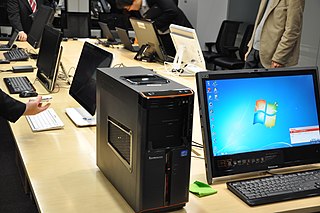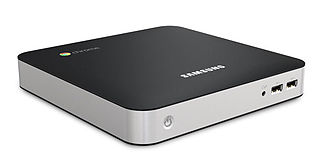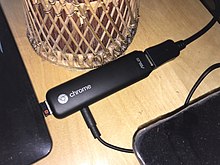OQO was a U.S. computer hardware company that was notable for manufacture of handheld computers. Its systems possessed the functionality of a tablet PC in a size slightly larger than a personal digital assistant (PDA). According to Guinness World Records, the "OQO" was the smallest full-powered, full-featured personal computer in 2005. The company's first version of subnotebook computer was the OQO model 01. It had been compared with the Ultra Mobile PC platform, although it was introduced before the UMPC took flight. The company was founded in 2000.

A netbook is a small and inexpensive laptop designed primarily as a means of accessing the Internet. Netbooks were sold from 2007 until around 2013, when the widespread advent of smartphones and tablets eclipsed their popularity.

ThinkCentre is a brand for a family of business-oriented desktop computers, the early models of which were designed, developed and marketed by International Business Machines (IBM) since 2003. In 2005, IBM sold its PC business, including the ThinkCentre brand, to Lenovo. ThinkCentre computers typically include mid-range to high-end processors, options for discrete graphics cards, and multi-monitor support.

A mini PC is a small-sized, inexpensive, low-power, legacy-free desktop computer designed for basic tasks such as web browsing, accessing web-based applications, document processing, and audio/video playback.

ChromeOS, sometimes styled as chromeOS and formerly styled as Chrome OS, is a Linux distribution developed and designed by Google. It is derived from the open-source ChromiumOS, based on the Linux kernel, and uses the Google Chrome web browser as its principal user interface.

A dongle is a small piece of computer hardware that connects to a port on another device to provide it with additional functionality, or enable a pass-through to such a device that adds functionality.
Chromebook is a line of netbooks and tablet computers that run using ChromeOS, a proprietary operating system developed by Google.

The Lenovo IdeaCentre is a line of consumer-oriented desktop computers designed, developed and marketed by Lenovo. The first IdeaCentre desktop, the IdeaCentre K210, was announced by Lenovo on June 30, 2008 as a consumer-focussed alternative to the business-oriented ThinkCentre and ThinkStation brandnames acquired from IBM. While the IdeaCentre line consists entirely of desktops, they share a common design language with the IdeaPad line of laptops and hybrids. One such feature is Veriface facial recognition technology.

Wireless Display (WiDi) is technology developed by Intel that enables users to stream music, movies, photos, videos and apps without cables from a compatible computer to a compatible HDTV or through the use of an adapter with other HDTVs or computer monitors. Intel WiDi supports HD 1080p video quality, 5.1 surround sound, and low latency for interacting with applications sent to the TV from a PC running Windows 7 or later.

A Chromebox is a small form-factor PC that runs Google's ChromeOS operating system. The first device debuted in May 2012.

The post-PC era was a market trend observed during the late 2000s and early 2010s involving a decline in the sales of personal computers (PCs) in favor of post-PC devices; which include mobile devices such as smartphones and tablet computers as well as other mobile computers such as wearable and ubiquitous ones. These devices emphasize portability and connectivity, including the use of cloud-based services, more focused "apps" to perform tasks, and the ability to synchronize information between multiple devices seamlessly.
The AMD LiveBox is an announced mini-desktop computer that was revealed at Computex 2012. It features a 1 GHz AMD C-60 processor, 1 GB of RAM, a Samsung 64 GB SSD, and Radeon 6200 graphics. With respect to connectivity, it will come with two USB 2.0 ports, a Gigabit Ethernet, HDMI, SD card slot, SIM slot and Bluetooth 4.0. There will be no need for any external power brick to power this device as it has its own built in power adapter. There is no WI-FI connectivity in the currently announced model and it is unknown whether there will be a version with such capabilities. It is comparable in size, usability and design as the Intel NUC. There has been no price or release date on the system, and no further details released on the topic. It is uncommon to see such a product being produced by AMD since the company hasn't played much of a role in the mini desktop scene. Since it is using an x86 based chip, it is capable of running Windows 7 which is also the operating system that it will come preinstalled with. It will also be able to support users wanting to upgrade to Windows 8 without any problems.
Miracast is a wireless communications standard created by the Wi-Fi Alliance which is designed to transmit video and sound from devices to display receivers. It uses Wi-Fi Direct to create an ad hoc encrypted wireless connection and can roughly be described as "HDMI over Wi-Fi", replacing cables in favor of wireless. Miracast is utilised in many devices and is used or branded under various names by different manufacturers, including Smart View, SmartShare, screen mirroring, Cast, wireless display and screen casting.

A stick PC or PC on a stick is a single-board computer in a small elongated casing resembling a stick, that can usually be plugged directly into an HDMI video port. A stick PC is a device which has independent CPUs or processing chips and which does not rely on another computer. It should not be confused with passive storage devices such as thumb drives.

Chromecast is a discontinued line of digital media players developed by Google. The devices, designed as small dongles, can play Internet-streamed audio-visual content on a high-definition television or home audio system. The user can control playback with a mobile device or personal computer through mobile and web apps that can use the Google Cast protocol, or by issuing commands via Google Assistant; later models introduced an interactive user interface and remote control. Content can be mirrored to video models from the Google Chrome web browser on a personal computer or from the screen of some Android devices.
Google Cast is a proprietary protocol developed by Google for playing locally stored or Internet-streamed audiovisual content on a compatible consumer device. The protocol is used to initiate and control playback of content on digital media players, high-definition televisions, and home audio systems using a mobile device, personal computer, or smart speaker. The protocol was first launched on July 24, 2013, to support Google's first-generation Chromecast player.

Amazon Fire TV is a line of digital media players and microconsoles developed by Amazon since 2014. The devices are small network appliances that deliver digital audio and video content streamed via the Internet to a connected high-definition television. They also allow users to access local content and to play video games with the included remote control or another game controller, or by using a mobile app remote control on another device.
Liquid computing refers to a style of workflow interaction of applications and computing services across multiple devices, such as computers, smartphones, and tablets. The term was coined in July 2014 by InfoWorld, but the underlying concepts have long existed in computer science, such as in the notions of pervasive computing and ubiquitous computing. The key differentiator for liquid computing over other related notions is that of being focused on the movement among devices of a workflow involving people.
EZCast is a line of digital media players, built by Actions Microelectronics, that allows users to mirror media content from smart devices, including mobile devices, personal computers, and project to high-definition televisions.

Nearby Share was a functionality developed by Google that allows data to be transferred between devices via Bluetooth, Wi-FI Direct or Internet. In 2024, it was merged into Samsung's Quick Share. It was available for Android, ChromeOS and Microsoft's Windows. It was first released on August 4, 2020.














